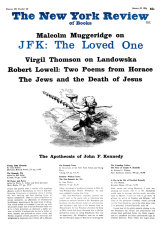In response to:
Critic from the November 5, 1964 issue
To the Editors:
I’m not convinced Michael Steinberg cannot infer the virtues of Toscanini’s performances from my phrase “plastic continuity.” I wouldn’t be even if I had written only those two words; but actually they are followed, on p. 80 of Music Observed, by a colon, and the colon is followed by
the continuum of sound moving in time is a plastic medium; and in the changes of sonority and pace which inflect the contour of the melodic line and shape the tonal mass in a Toscanini performance, one hears the operation of an unerring plastic sense on that medium—a plastic sense which makes each change of sonority or pace proportional to what precedes and follows, thus gives the developing form in sound coherence, etc.
As it happens, this passage was quoted in its entirety by the reviewer in Columbia Spectator, who added that to verify the “exactitude” of the description one needed only to listen to a Toscanini performance. And Mr. Steinberg will never get me to believe he can’t hear the relevance of my description that an undergraduate English major hears.
I am troubled by other important instances of Mr. Steinberg’s quoting part of a statement and not the rest that completes it. Contending that my report of hearing “synthetic substance being manipulated by formula” in a Brahms sonata is—without explanation of the terms “synthetic substance” and “manipulated by formula”—not criticism but only “the announcement of a personal reaction,” Mr. Steinberg quotes a sentence from another article: “As though criticism properly was something other or more than personal likes and dislikes, and as though such likes and dislikes were mere whim”—which he says is not convincing. But it might be more convincing if completed by the next sentence: “Actually criticism is as personal as the art it deals with: it begins with the critic’s experience of, and response to, the work of art with his particular resources for the purpose; it ends with a formulation of his judgment that is a reasoned statement of like or dislike.” And I will add that our Columbia English major is one of those for whom “synthetic substance” and “manipulated by formula” are, without explanation, clear as descriptions of what they hear in the Brahms sonata, and for whom this makes my statement criticism.
I cannot deal here with all the instances, but must deal with one more. As an example of writing about other writers that isn’t always valuable Mr. Steinberg cites my statement that “anyone familiar with the last movement of Beethoven’s Quartet Opus 130, and the last movement of Schubert’s posthumous Sonata in B-flat, is in a position to see that Einstein’s assertion of their relation…is nonsense.” (He doubts my “genuine inability to hear the obvious”; but I assure him of my genuine inability to hear what is not there to be heard.) Even as Mr. Steinberg quotes it the statement is valuable as part of my material establishing the pretentious and shoddy character of the Einstein operation; but it is even more valuable with the additional words represented by the three dots: “…Einstein’s assertion of their relation is—like most of his endless twitterings about derivations of one piece of music from another—nonsense.”
For a critic to describe and evaluate accurately the object before him—a piece of music, a performance, a book—he must, obviously, have specialized perception; but he must also, it turns out, have discipline—and I don’t mean just intellectual discipline.
B. H. Haggin
New York City
This Issue
January 28, 1965



